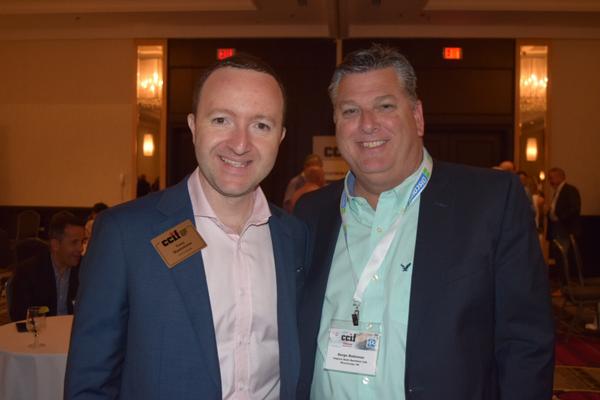By Erin McLaughin
Fredericton, New Brunswick — May 28, 2017 — The second CCIF of 2017 drew over 250 attendees to the Delta Fredericton in Fredericton, New Brunswick. The atmosphere was electric with rich conversation, passion and a willingness to learn and improve. It was very clear the desire to better the industry in every way was at the forefront of attendee concerns.
Mike O’Brien, the Mayor of Fredericton, kicked the meeting off with a summary of the history of Fredericton and New Brunswick, and warmly shared his own evolving perception of the collision repair industry. “When I was first introduced to a collision repair shop, it was a dirty building with no ventilation, and people were smoking cigarettes while working on cars,” he said. “Now shops are pristine and employee-centric.”
Brigitte Pesant, CCIF Administrator, and Joe Carvalho of Economical Insurance, CCIF Chairman delivered the opening remarks before welcoming Annabelle Cormack, President and Founder of Cormack Recruitment to the stage. Her presentation, “Making a Dent in Recruitment,” focused on hiring tactics employers should adopt in order to successfully recruit talented and capable individuals. We tend to hire “reactively,” she said. Hiring someone is usually unplanned and unexpected, which results in going into panic-mode and hiring less than ideal employees. Instead, she argued, we should hire in a way that is “planned and intentional, proactive rather than reactive.” Cormack presented three tactics for proactive hiring: plan and anticipate, network and maintain momentum.
Following Cormack was Patrice Marcil of Axalta Coating Systems, with the Collision Industry-Education Connection Project Update. He stated that the main objective was to engage the collision repair industry through the CCIF by collaborating with recruitment, development and employee retention. He went into more detail, outlining the four action items the CCIF committee focuses on: the roles of a collision centre, instructor development, workforce retention and school improvement and support.
This concern towards raising the educational standards for future repairers was at the forefront of many discussions throughout the conference. Improving education programs offered in high schools, which would likely improve young student’s understanding of what the collision repair industry actually is, could offer up a world of new opportunities for many students and improve recruiting prospects for employers. During her presentation, Cormack suggested creating “a shopping mall of information for students” as potential step towards giving students all the information they might need to know what it means to work in the collision repair industry.
After a short break, Pesant joined Marcil on the stage to provide an overview of the Collision Industry-Education Connection Program. This is a year-long sponsorship program consisting of various opportunities, including financial and in-kind opportunities. “We want to help schools be able to offer training that is in line with what is actually needed in the collision repair industry,” noted one of the speakers.
Andrew Shepherd of I-CAR Canada following, presenting an update on the training organization’s plans for the near future. “15 to 20 new courses will start to come out, because OEMs want to get technical information out there, and I-CAR will be the avenue to do that,” he said. “As well as that, we can expect shorter courses (one to two hours instead of four) that are more specific to one’s needs. There will also be more vehicle-specific courses available.”
Brandon Roy, a Product Specialist with Axalta Coating Systems and an instructor for I-CAR Canada, followed. He spoke on new technologies that were beginning to appear in the automotive industry, including pre- and post-scanning and the advantages of doing so, such as quality control. He also discussed Corning’s Gorilla Glass, which features stronger, but thinner glass. “Vehicles are getting heavier from [increased] tech,” Roy noted. “OEMs are trying to figure out how to lighten it.” Roy also touched one the coming age of intelligent damage protection systems, which can tell drivers and repairers about a damaged panel using sensors bonded to the panel’s backside.
After lunch, Carvalho took the stage once again to present an overview of diagnostic scanning. Following Carvalho, attendees heard from Jean-Luc Sauriol of ALLDATA. Sauriol presented a pre- and post-scan analysis, including information on YAW-Rate sensors, why one should perform a pre-scan, the benefits of freeze frame data (which includes getting information on the engine’s RPM/vehicle speed/fuel tank level/temperature/location at the time of the collision) as well as a live demonstration of a scan. Sauriol hammered home the point that anyone is capable of learning how to scan. “I can teach you to scan in ten minutes. You can do that,” he said. “It doesn’t matter if it’s a Ford or Chrysler, [it] pretty much [works] all the same.” After performing the scan, which consisted mainly of following the scanning device’s directions, Saurio asked the audience, “was that easy?” To which the audience replied, “yes!”
Jim Kenzie, an automotive journalist with the Toronto Star and TSN’s Motoring TV, finished off with the final presentation of the day. His presentation touched on several themes, including vehicle safety, as well as autonomous and electric vehicles. Electric vehicles, he stated, “were promised to be a saving grace from the petroleum infested world,” but he is uncertain whether or not this is possible.
“Our electric infrastructure simply cannot handle [too many] electric vehicles. Where are we going to get that much electricity? And even if we build a nuclear generator, whose backyard will we put it in?” He also noted that we use diesel powered vehicles to transport electric batteries. “Until we can eliminate all diesel vehicles from the making of electric vehicles, we have a long way to go.”
The next CCIF meeting takes place September 28 and 29 at the Westin Edmonton in Edmonton, Alberta. For more information, please click here.










































